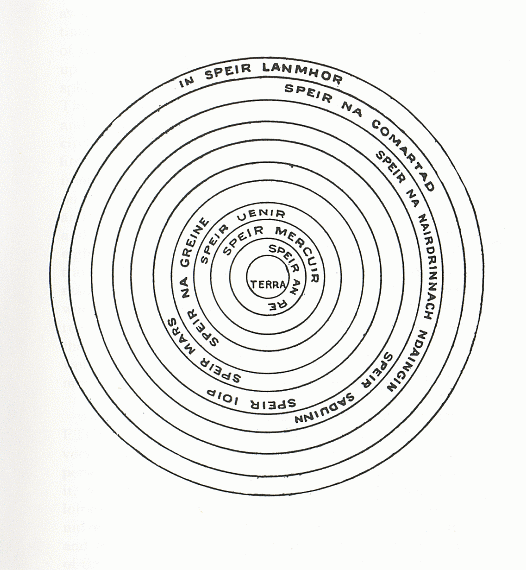
As that philosopher152 says, we see two kinds of motion in the firmament—one motion from east to west and the other from west to east of the world. The motion of the sun, moon and each of the other five planets corresponds to the extent of the amplitude of their own spheres in the eastward motion. The westward motion moreover carries the planets with it in a contrary direction, in opposition to their natural motion which is eastward. I repeat that the sun moon, and other five planets and all the fixed stars have the same equal motion,153 for of them all individually, there is no star which moves more swiftly or more slowly than the other. Therefore, there is no difference in the world between the motion of the sun and moon, and the motion of the other stars, because it is certain that they have the same nature and form. Although Saturn appears to be slower than the moon in consequence of the reason I shall now relate, their motion is equal.
As Ptolemy and the other philosophers declare, there are ten large spheres,154 and the largest sphere of those, which is called the Very Great Sphere, possesses the same motion as the Sphere of the Signs, since both move westward. The motion of the eight spheres moreover, i.e., the sphere of the fixed stars and that of the sun and of the moon and of the other five planets, is from the west to the east of the world, as I have frequently remarked, and those spheres are situated within each other; and the sphere of the moon is the nearest to the earth, and then the spheres of Mercury and Venus respectively, and that of the sun outside those, and the spheres of Mars and Jupiter outside those, and the sphere of the fixed stars outside those. It is not because, they do not move that they are called fixed stars, for they move from the west of the world to the east, as do the other planets, but because they do not incline from the north of the firmament155 to the south, as do those others. The Sphere of the Signs is the ninth sphere, and outside those one and all is the tenth sphere called the "very great sphere", or by another name, "the direct (or right) sphere."156 Herewith is a figure157 which represents them all.
I said above that the moon appears swifter than Saturn. If the moon were in the orbit of Saturn, it would be thirty years travelling as Saturn travels158. Similarly Saturn would traverse the orbit of the moon, if it were in it, in a period of
Ptolemy162 gave a clear example to explain the two motions I mentioned above, from east to west and from west to east of the world. Imagine that a wheel163 revolved from the east of the world to the west in a day and a night, and that there was a small circle around the centre of that wheel, and a circle twice as large outside it, and a third circle outside that three times as large as the first circle, the fourth circle outside of that four times larger than the first circle, and so on up to the eighth circle. And if a ball164 were in each and every circle of them, moving from the west of the world to the east (with equal linear velocities), then this wheel would represent the very great sphere of the world and the small circles I mentioned would be like the inner circles of that great sphere. Now, when the first ball completes its first revolution, the second ball will be on the second half of its round, and the third ball on the third part, and the fourth ball on the fourth and the fifth on the fifth, and the sixth on the sixth, and the seventh on the seventh, and the eighth on the eighth165. Thus while the eighth ball would have traversed its whole course the first ball would have made eight revolutions. Whilst those eight balls would be fulfilling their circular course, the wheel would revolve very frequently between those
And to enlighten the mind of the reader I have set down this diagram.
